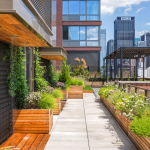As you navigate the bustling streets of Singapore, you’ve likely noticed a shift in the way people live and work. The traditional 9-to-5 routine is giving way to a more fluid, flexible lifestyle, with remote work and entrepreneurship on the rise. But what does this mean for your living arrangements? Enter co-living, a revolutionary concept that’s transforming the way you think about shared spaces.
In this thriving metropolis, co-living is emerging as the perfect solution for your mobile workforce, offering a unique blend of community, convenience, and flexibility. Let’s explore how this trend is redefining the way you live, work, and interact in Singapore.
The Shift to Mobility
For decades, the traditional 9-to-5 office routine has been the norm. But with the rise of technology and changing workforce demographics, the way you work is undergoing a significant transformation.
The Rise of Remote Work
With the proliferation of digital tools and high-speed internet, you’re no longer tethered to a specific location to get your job done. Remote work has become increasingly popular, allowing you to work from your cosy home at Norwood Grand, at any time. This shift has been driven by the growing demand for flexibility and work-life balance.
As a result, the boundaries between work and personal life have become increasingly blurred, and the concept of a traditional office space has become less relevant. With remote work, you’re no longer confined to a specific location or schedule. You can work from a coffee shop, a co-working space, or even your own home.
This flexibility has opened up new opportunities for people to work on their own terms, and has enabled companies to tap into a global talent pool.
Singapore’s Changing Demographics
Singapore’s workforce is becoming increasingly mobile, with more people moving to the city-state for work opportunities. This influx of talent has brought about a shift in demographics, with a growing number of young, urban professionals who value flexibility and convenience.
Shift your attention to the demographics of Singapore’s workforce, and you’ll notice that there’s a growing trend towards mobility. With a rising number of singles, couples, and young families, the traditional notion of a fixed abode is giving way to a more transient lifestyle. This shift has created a demand for flexible, short-term living arrangements that can cater to the needs of this mobile workforce.
Co-Living as a Solution
There’s no denying that the modern workforce is becoming increasingly mobile. With the rise of remote work and digital nomadism, people are no longer tied to a specific location or traditional 9-to-5 job. As a result, there’s a growing need for flexible and affordable housing options that cater to this new lifestyle.
Shared Spaces for the Modern Nomad
Co-Living spaces at The Hill at One North offer a unique solution to this problem. By providing shared living areas, community kitchens, and collaborative workspaces, co-living spaces cater specifically to the needs of mobile workers. You’re no longer tied to a traditional lease or utility bills, and you have the freedom to move around as your work requires. Plus, you’re surrounded by like-minded individuals who understand the demands of a mobile lifestyle.
In a co-living space, you’ll find amenities that are designed to support your nomadic lifestyle. From high-speed internet to networking events, everything is geared towards helping you stay connected and productive on the go. And when you need some downtime, you can retreat to your private quarters or relax in the communal lounge area.
Benefits of Community Living
One of the most significant advantages of co-living spaces is the sense of community they provide. You’re no longer isolated in a solo apartment or struggling to make connections in a new city. Instead, you’re part of a vibrant community of like-minded individuals who share your values and goals.
In a co-living space, you’ll find people from all walks of life, each with their own unique experiences and perspectives. You’ll have the opportunity to learn from others, share your own knowledge, and build meaningful relationships that can last a lifetime. And when you need support or guidance, you’ll have a built-in network of peers who understand what you’re going through.
Benefits of community living extend far beyond the social aspect, however. You’ll also enjoy cost savings from shared amenities and services, as well as access to exclusive events and workshops designed to help you grow personally and professionally.
In a co-living space, you’ll find a true sense of belonging and connection – something that’s often missing in traditional housing arrangements.
The Co-Living Landscape in Singapore
Some of the most exciting developments in the co-living space are happening right here in Singapore, and as you investigate into the world of shared living, you’ll discover a landscape that’s rapidly evolving to meet the needs of the city-state’s mobile workforce.
Current State of the Market
Status quo, Singapore’s co-living market is characterized by a proliferation of players, each vying for a slice of the pie. You’ll find established operators like lyf and Hmlet, alongside newer entrants, all offering a range of accommodation options that cater to different budgets and lifestyles.
As you explore the market, you’ll notice that most co-living spaces are concentrated in central locations, such as Tanjong Pagar, River Valley, and Tiong Bahru, which offer easy access to public transportation and amenities.
Despite the growing demand for co-living spaces, you’ll find that supply is still limited, particularly in the mid-range segment. This has led to a situation where prices are relatively high, making it challenging for some individuals to access these shared living arrangements.
However, as the market continues to mature, you can expect to see more affordable options emerge, catering to a broader range of budgets and needs.
Emerging Trends and Opportunities
Singapore’s co-living landscape is poised for significant growth, driven by shifting demographics, technological advancements, and changing attitudes towards shared living. As you look ahead, you’ll notice that co-living operators are increasingly focusing on community-building, curating experiences that foster connections and a sense of belonging among residents.
With the rise of remote work, you’ll see co-living spaces evolving to incorporate more flexible, modular designs that can adapt to the changing needs of residents. This might include shared workspaces, event areas, and amenities that cater to the unique requirements of digital nomads and entrepreneurs.
With the Singaporean government’s emphasis on sustainable development and community engagement, you can expect to see co-living spaces incorporating more eco-friendly features and partnering with local organizations to create positive social impact. This could include initiatives like urban farming, community art projects, or mentorship programs, all designed to foster a sense of connection and responsibility among residents.
The Future of Co-Living
As you consider the rapid growth of co-living spaces in Singapore, it’s imperative to think about what the future holds for this innovative way of living. The truth is, co-living is not just a fleeting trend, but a response to the changing needs of the modern workforce. Your lifestyle, priorities, and values are shifting, and co-living spaces are adapting to meet those demands.
Integrating Technology and Design
Designing co-living spaces that seamlessly merge technology and comfort is crucial for their success. Imagine walking into your co-living space, and your favorite music starts playing, the lights adjust to your preferred brightness, and your coffee is ready just the way you like it.
This is the future of co-living, where smart home technology integrates with thoughtful design to create a truly personalized experience. As co-living spaces continue to evolve, you can expect to see more innovative uses of technology, such as AI-powered concierge services, virtual reality social spaces, and even biometric security systems.
By incorporating technology into the design of co-living spaces, developers can create a more efficient, convenient, and enjoyable living experience for residents. This might include features like automated package delivery, smart energy management, and even personalized wellness programs.
The possibilities are endless, and it’s exciting to think about how co-living spaces will continue to push the boundaries of what’s possible.
Addressing Concerns and Challenges
To fully realize the potential of co-living, it’s imperative to address the concerns and challenges that come with this new way of living. One of the primary concerns is privacy – how do you balance the need for community and social interaction with the desire for personal space and alone time?
Co-living spaces must be designed with this in mind, incorporating features like private workspaces, soundproofing, and flexible layouts that can adapt to different needs and preferences. Technology will also play a critical role in addressing concerns around safety and security.
With features like biometric authentication, smart locks, and AI-powered surveillance systems, co-living spaces can provide an added layer of protection and peace of mind for residents. By leveraging technology and design, co-living spaces can create a safe, comfortable, and welcoming environment that meets the unique needs of Singapore’s mobile workforce.
Technology will be key in addressing the concerns around community building and social isolation. With the help of digital platforms, co-living spaces can facilitate connections between residents, hosting virtual events, and creating online forums for discussion and collaboration. This will enable residents to build meaningful relationships, even when they’re not physically present in the same space.
Summing up
With this in mind, you may be wondering what the future holds for co-living spaces in Singapore. As the city-state continues to evolve into a hub for innovation and entrepreneurship, it’s likely that the demand for shared living arrangements will only increase.
You’re probably not alone in thinking that the traditional 9-to-5 job is becoming a relic of the past, and that the modern workforce values flexibility and community above all else. Co-living spaces are perfectly positioned to cater to this shift, offering a unique blend of convenience, affordability, and social connection that’s hard to find elsewhere.
As you look to the horizon, it’s exciting to consider the possibilities that co-living spaces might unlock for Singapore’s mobile workforce. Will we see a proliferation of co-living developments across the city, each one tailored to the specific needs of its residents? Will these shared spaces become incubators for innovation, fostering collaboration and creativity among their inhabitants?
The answers to these questions remain to be seen, but one thing is clear: co-living is here to stay, and it’s poised to revolutionize the way you live, work, and interact with your community.
Lynn Martelli is an editor at Readability. She received her MFA in Creative Writing from Antioch University and has worked as an editor for over 10 years. Lynn has edited a wide variety of books, including fiction, non-fiction, memoirs, and more. In her free time, Lynn enjoys reading, writing, and spending time with her family and friends.















